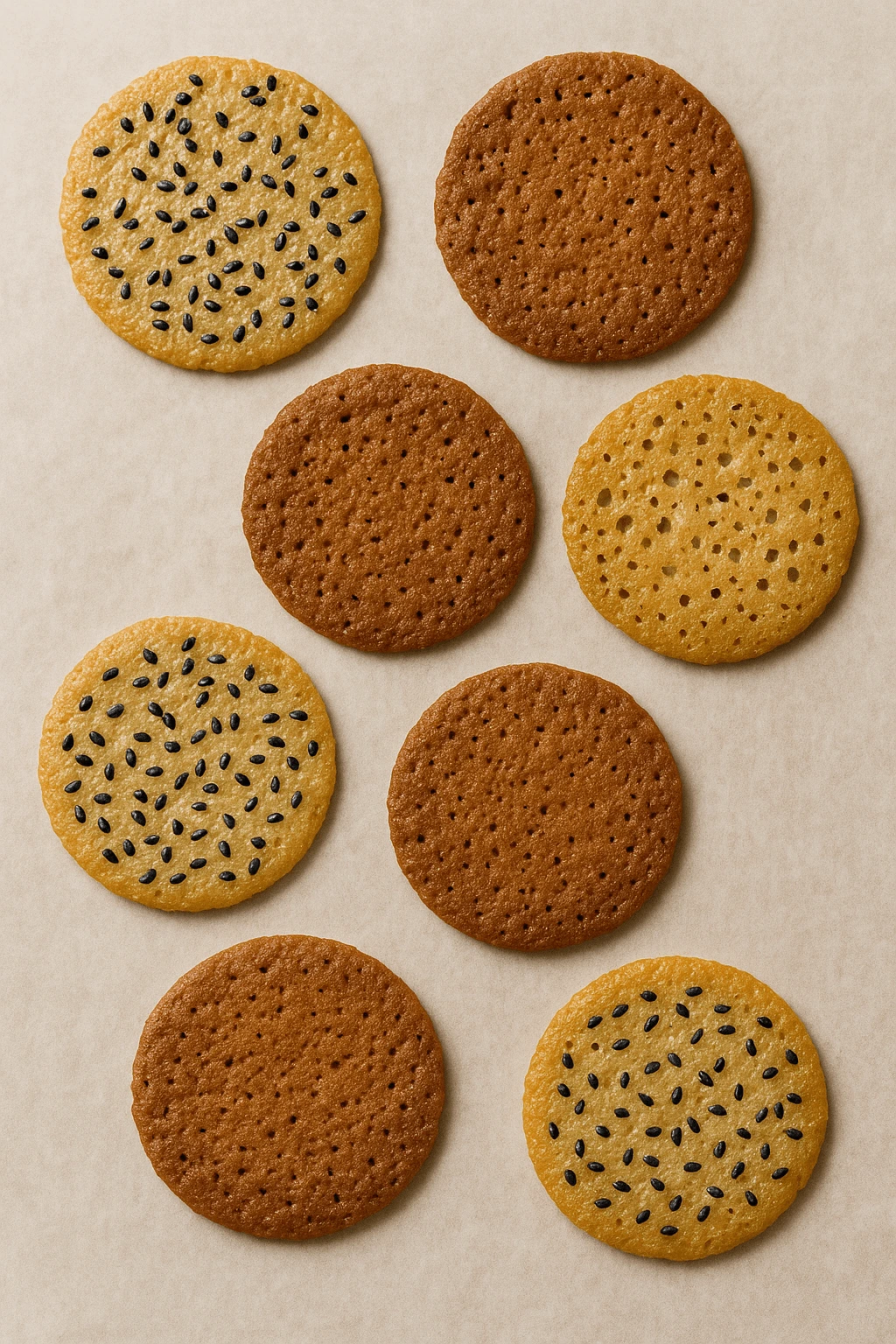Black sesame tuiles
These black sesame and gingerbread tuiles are not mere garnishes — they are a poetic expression of contrast and balance, tradition and boldness. With their ultra-thin structure and graceful curve, they whisper elegance at first glance, before unfolding a full sensory journey on the palate.
The texture is crisp and whisper-light, offering a refined snap that gives way to a surprising depth of flavor. The warming, nostalgic notes of gingerbread evoke festive kitchens, winter spices, and golden warmth. But then comes the unexpected: the deep, toasty, slightly bitter allure of black sesame, adding intensity and intrigue. Together, they form a surprising harmony — comforting yet complex, familiar yet boldly modern.
Visually stunning with their lace-like silhouette and subtle sheen, these tuiles are as much a feast for the eyes as for the senses. They elevate a plated dessert with texture and finesse, pair perfectly with a scoop of sorbet or a silky mousse, and can even stand alone as a statement of culinary artistry.
Far more than a crisp cookie, each tuile tells a story. It’s a story of refined technique meeting emotional resonance — of French pastry traditions embracing faraway flavors. It’s about giving voice to simplicity, letting texture and aroma do the talking, and transforming a small bite into a lasting impression.
Whether part of a refined dessert course or served alongside an afternoon tea, these tuiles bring elegance, personality, and a spark of the unexpected — making them an unforgettable touch in any pastry chef’s repertoire.
A Pastry with Character
There’s a delicate moment in pâtisserie when simplicity meets elegance — and this recipe captures that very instant. These tuiles, infused with the toasty depth of black sesame and the comforting warmth of gingerbread, offer a texture-driven experience that seduces from the very first bite.
Designed to yield around 20 crisp, lacy rounds, the process begins with a quiet transformation: a slice of gingerbread, once soft and spongy, is finely ground and dried in a low oven. This step, though seemingly modest, is what gives the final result its soulful complexity. The dried crumb becomes aromatic powder — concentrated in flavor, with hints of honey, clove, and anise that bloom in the heat of baking.
Tuiles au sésame noir et au pain d’épices Black sesame tuiles
Quantité : 20 tuiles
Préparation : 20 minutes
Repos (facultatif) : 30 minutes
Cuisson : 3 minutes
Ingrédients
Pour la poudre de pain d’épices séchée :
- 1 tranche de pain d’épice (permet d’obtenir environ 1 cuillère à café de poudre)
Pour la pâte à tuile :
- 2 blancs d’œufs (env. 60 g)
- 4 gros œufs entiers (env. 210 g)
- 65 g de beurre
- 60 g de farine (type 45)
- 130 g de sucre glace
- 130 g de sucre vergeoise brune
- 1 cuillère à café rase d’épices à pain d’épice (ou cannelle)
- 130 g de sésame noir
Finition :
- Quelques graines de sésame noir supplémentaires
- Quelques grains de fleur de se
The Art of Tuile Batter
Creating the perfect tuile batter is about balance: moisture, fat, and the right blend of sugars. In this recipe, egg whites and whole eggs come together, offering both structure and fluidity. Melted butter — added while still warm — binds the batter into a supple, semi-liquid mixture, while flour provides just enough body without compromising the desired thinness.
But it’s the use of two types of sugar that truly elevates this recipe: icing sugar ensures the batter dissolves smoothly, giving a fine-grain texture that disappears once baked, while dark brown vergeoise brings depth and a hint of molasses-like richness. This duo not only creates a beautifully even caramelization during baking, but also allows the tuile to be worked with immediately — no graininess, no waiting time.
The dry mix — flour, sugars, ground gingerbread, black sesame, and warming spice — forms the aromatic backbone. A touch of gingerbread spice mix (or simply cinnamon, in a pinch) reawakens the notes of winter pastry traditions, while the black sesame brings bold contrast: visually striking, slightly bitter, with a roasted undertone that plays beautifully against the sweetness.
The Bake: Thin, Crisp, Elegant
Shaping the tuiles is a tactile pleasure. Using fingers, the chilled batter is spread onto parchment-lined trays in thin, round circles roughly 5 cm across. The key is achieving a thickness of 1 to 2 mm — thin enough to turn crisp, thick enough to hold their shape. A few extra black sesame seeds and a sprinkle of fleur de sel finish each one, enhancing not just texture but also that magical tension between sweet and savory.
Baking takes just 3 minutes at 180°C. The transformation is fast: the batter melts, spreads slightly, and caramelizes to a light amber with deep specks of sesame throughout.
And here comes the crucial moment — the shaping. Straight from the oven, the tuiles are still flexible. This is your chance to give them their signature curved form. Draped gently over a rolling pin, a bottle, or shaped by hand, they firm up within minutes as they cool, retaining that perfect, crisp arch.
A Few Words on Taste and Technique
Why use both icing sugar and vergeoise in this recipe?
Each serves a distinct role. Vergeoise provides complexity and a caramel backbone, while icing sugar ensures finesse — it melts into the batter seamlessly and guarantees a smooth, refined finish. Combined, they yield a tuile that’s both flavorful and delicate — no graininess, no crunch from undissolved sugar.
Serving Ideas
These tuiles are astonishingly versatile. Serve them as a crunchy counterpoint to a creamy dessert — a scoop of black sesame ice cream, a quenelle of mascarpone chantilly, or a dark chocolate mousse. They’re equally at home alongside a fruit-based dessert (poached pears, spiced plums) or as an elevated garnish for plated desserts in a professional setting.
Even alone, with a cup of tea or coffee, they offer a deeply satisfying bite: nostalgic, textured, aromatic.
Chef’s Tip
If you want your tuiles to retain maximum crispness, store them in an airtight container as soon as they’ve cooled. They’re best enjoyed within 24–48 hours for optimal snap and aroma.
Conclusion
Light as a whisper and bold in flavor, these black sesame and gingerbread tuiles are proof that finesse doesn’t require complexity. In just a few minutes, they offer texture, aroma, and a spark of originality that elevates any dessert plate. Whether paired with a mousse, a sorbet, or enjoyed simply with tea, they bring that magical contrast between crunch and warmth.
Now it’s your turn to create the perfect snap — and let every bite tell a story.
Questions & Answers
Can I replace black sesame seeds?
Yes — you can substitute with white sesame for a milder flavor or even poppy seeds. However, black sesame offers a unique nutty bitterness and deep color that’s hard to replicate.
What if I don’t have gingerbread?
You can blend a spiced biscuit (like speculoos) or use fine breadcrumbs mixed with a pinch of warm spices (cinnamon, nutmeg, clove). While not identical, the spirit of the recipe will remain intact.
Can I make them ahead of time?
Absolutely. Once baked and cooled, these tuiles keep well for 2 to 3 days in an airtight container. Make sure to store them away from moisture and never leave them exposed to air, or they’ll lose their crispness.
Why do my tuiles come out soft?
Usually, this is due to a batter that’s too thick or a bake that’s too short. Spread the batter very thinly (1 to 2 mm) and bake until the edges are visibly golden.
Can I prepare the batter in advance?
Yes. In fact, letting the batter rest in the fridge for a few hours (or overnight) improves the texture. Just give it a gentle stir before using.Tarte au citron haute couture
👉 “These tuiles are perfect alongside a tangy lemon cream — like our Ultimate Lemon Tart Recipe”À insérer discrètement mais stratégiquement (1–3 suffisent) :
Qu’est-ce que la vergeoise ?
👉 “Learn more about vergeoise sugar here”
(Site Delifrance ou un dictionnaire culinaire sérieux)

